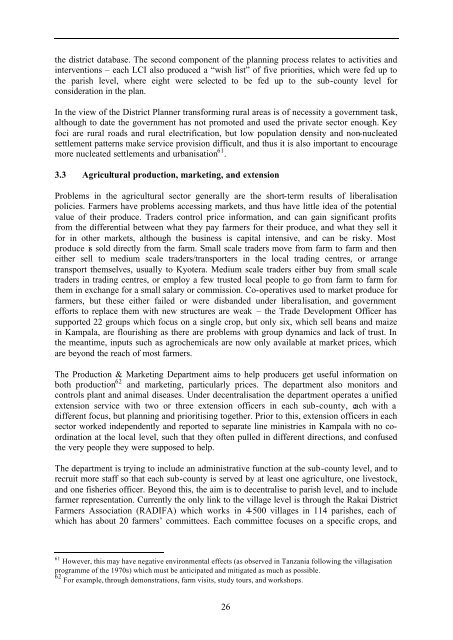Access to Rural Non-Farm Livelihoods - Natural Resources Institute
Access to Rural Non-Farm Livelihoods - Natural Resources Institute
Access to Rural Non-Farm Livelihoods - Natural Resources Institute
You also want an ePaper? Increase the reach of your titles
YUMPU automatically turns print PDFs into web optimized ePapers that Google loves.
the district database. The second component of the planning process relates <strong>to</strong> activities and<br />
interventions – each LCI also produced a “wish list” of five priorities, which were fed up <strong>to</strong><br />
the parish level, where eight were selected <strong>to</strong> be fed up <strong>to</strong> the sub-county level for<br />
consideration in the plan.<br />
In the view of the District Planner transforming rural areas is of necessity a government task,<br />
although <strong>to</strong> date the government has not promoted and used the private sec<strong>to</strong>r enough. Key<br />
foci are rural roads and rural electrification, but low population density and non-nucleated<br />
settlement patterns make service provision difficult, and thus it is also important <strong>to</strong> encourage<br />
more nucleated settlements and urbanisation 61 .<br />
3.3 Agricultural production, marketing, and extension<br />
Problems in the agricultural sec<strong>to</strong>r generally are the short-term results of liberalisation<br />
policies. <strong>Farm</strong>ers have problems accessing markets, and thus have little idea of the potential<br />
value of their produce. Traders control price information, and can gain significant profits<br />
from the differential between what they pay farmers for their produce, and what they sell it<br />
for in other markets, although the business is capital intensive, and can be risky. Most<br />
produce is sold directly from the farm. Small scale traders move from farm <strong>to</strong> farm and then<br />
either sell <strong>to</strong> medium scale traders/transporters in the local trading centres, or arrange<br />
transport themselves, usually <strong>to</strong> Kyotera. Medium scale traders either buy from small scale<br />
traders in trading centres, or employ a few trusted local people <strong>to</strong> go from farm <strong>to</strong> farm for<br />
them in exchange for a small salary or commission. Co-operatives used <strong>to</strong> market produce for<br />
farmers, but these either failed or were disbanded under liberalisation, and government<br />
efforts <strong>to</strong> replace them with new structures are weak – the Trade Development Officer has<br />
supported 22 groups which focus on a single crop, but only six, which sell beans and maize<br />
in Kampala, are flourishing as there are problems with group dynamics and lack of trust. In<br />
the meantime, inputs such as agrochemicals are now only available at market prices, which<br />
are beyond the reach of most farmers.<br />
The Production & Marketing Department aims <strong>to</strong> help producers get useful information on<br />
both production 62 and marketing, particularly prices. The department also moni<strong>to</strong>rs and<br />
controls plant and animal diseases. Under decentralisation the department operates a unified<br />
extension service with two or three extension officers in each sub-county, each with a<br />
different focus, but planning and prioritising <strong>to</strong>gether. Prior <strong>to</strong> this, extension officers in each<br />
sec<strong>to</strong>r worked independently and reported <strong>to</strong> separate line ministries in Kampala with no coordination<br />
at the local level, such that they often pulled in different directions, and confused<br />
the very people they were supposed <strong>to</strong> help.<br />
The department is trying <strong>to</strong> include an administrative function at the sub-county level, and <strong>to</strong><br />
recruit more staff so that each sub-county is served by at least one agriculture, one lives<strong>to</strong>ck,<br />
and one fisheries officer. Beyond this, the aim is <strong>to</strong> decentralise <strong>to</strong> parish level, and <strong>to</strong> include<br />
farmer representation. Currently the only link <strong>to</strong> the village level is through the Rakai District<br />
<strong>Farm</strong>ers Association (RADIFA) which works in 4-500 villages in 114 parishes, each of<br />
which has about 20 farmers’ committees. Each committee focuses on a specific crops, and<br />
61 However, this may have negative environmental effects (as observed in Tanzania following the villagisation<br />
programme of the 1970s) which must be anticipated and mitigated as much as possible.<br />
62 For example, through demonstrations, farm visits, study <strong>to</strong>urs, and workshops.<br />
26

















